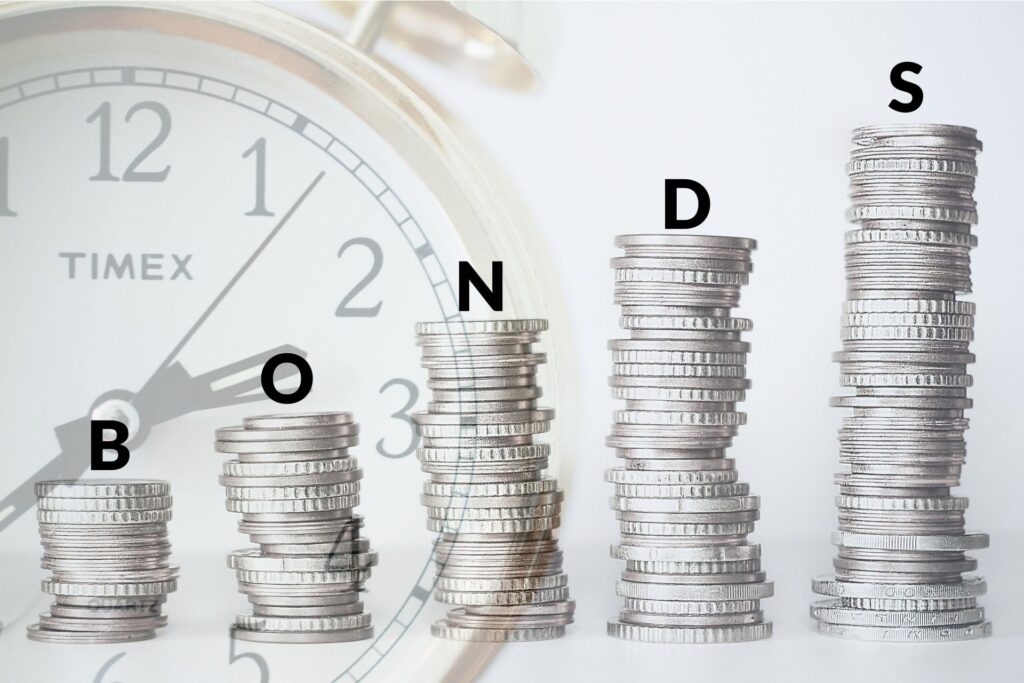
What do You Mean by bonds?
A bond is a fixed-income instrument representing a loan between an investor and a borrower. It operates like an I.O.U between the bond issuer and the bondholder.
When buying bonds, the investor lends money to the issuer. The issuer promises to repay the principal amount with a fixed interest rate at a future date. As an investor, you become a debt holder for the entity that issues the bond, providing them with capital.
Governments rely on bonds for funding and to supplement their revenue from taxes. Most companies issue bonds to finance acquisitions, new projects, and ongoing operations.
How Does Bond Work?

They are financial instruments that allow individual investors to allocate their capital among various asset classes, including stocks (equities) and cash equivalents. When companies or governments issue bonds, they are essentially borrowing money from investors. Each bond has a principal amount, a maturity date, and an interest payment, known as the coupon.
The bond principal represents the amount borrowed, while the maturity date signifies when it’ll be repaid. The coupon rate is paid to bondholders, typically expressed as a percentage of the bond’s face value. Investors purchase bonds at an initial market price, which may differ from the face value. This difference reflects the prevailing interest rates; bonds with higher coupon rates are more attractive to investors in a lower-cost interest environment.
As time progresses, the actual market price of a bond can fluctuate based on changes in interest rates. Bondholders receive periodic interest payments until the bond reaches its maturity date, at which point they receive the face value. They provide a predictable stream of income and are considered a lower-risk investment compared to stocks.
Who issues Bonds?
Bonds, essentially debt instruments, are commonly issued by both governments and corporations as a means of raising funds for diverse purposes. Government entities, spanning all levels, often turn to bonds to finance essential infrastructure projects like schools, roads, and dams. In times of unexpected financial demands, such as during wartime expenditures, governments also utilize them to secure the necessary capital.
Similarly, corporations frequently opt for bond issuance to fuel their growth, acquire assets, embark on lucrative ventures, support research and development endeavours, or expand their workforce. The challenge for these large organizations lies in their substantial financial needs, which often surpass what conventional banks can provide.
Bonds bridge this gap effectively by allowing numerous individual investors to step into the role of lenders. Public debt markets serve as a platform where thousands of investors can collectively contribute the required capital. Moreover, these markets offer the flexibility for lenders to trade bonds among themselves, enabling them to sell them to other investors or purchase from fellow individuals. This trading can occur long after the initial issuer has already obtained the necessary capital.
Characteristics of Bonds
Some basic features include:
1. Coupon Rate (Interest Rate):
The coupon rate is the interest rate that the bond issuer promises to pay you, usually on an annual basis. For instance, if you have a bond with a $1,000 face value and a 5% coupon rate, you’ll receive $50 in interest per year.
2. Coupon Date (Interest Payment Date):
This is the date when you receive your interest payment, which typically occurs semi-annually or annually, depending on the bond terms. For example, your bond might have a coupon date of June 1st or December 1st.
3. Maturity Date:
The maturity date is when it reaches the end of its life and you, as a bondholder, get back the face value of the bond. If you hold a 10-year bond issued on January 1, 2023, it will mature on January 1, 2033.
4. Face Value (Par Value):
The face value is the amount you’ll receive when it matures. It is the amount that the bond issuer uses to calculate the interest. If your bond’s face value is $1,000, you’ll get $1,000 back at maturity.
5. Issue Price (Initial Purchase Price):
The issue price is the cost at which you buy the bond initially. It can be different from the face value. For example, if you buy it with a face value of $1,000 for $950, the issue price is $950.
6. Credit Rating:
A credit rating assesses the bond issuer’s creditworthiness. It helps you gauge the risk associated with the bond. For instance, a bond with a high credit rating, like “AAA,” signifies low risk, while “BB” indicates higher risk.
7. Yield (Yield to Maturity):
The yield represents the total return you’ll earn from it, including interest and any potential capital gains or losses. It varies based on market conditions and your purchase price.
8. Liquidity:
Liquidity refers to how easily you can buy or sell them in the market. Highly liquid bonds can be bought or sold quickly without significant price fluctuations, while less liquid bonds may have wider bid-ask spreads, potentially affecting your transaction costs.
Different Varieties Of Bonds
They come in various types and can differ from each other. Some factors that make them unique include coupon payments or interest rates, callable or non-callable status, and other attributes.
Let’s look at some of the most common types.
(i)Callable
When a company issues callable bonds, it reserves the right to recall or buy them back before maturity. This means that if the company’s credit rating improves or interest rates decline, the company can call the bonds back and issue new ones at a lower coupon rate.
For instance, suppose a company issue bonds with a 7% coupon rate and a 10-year maturity. If, after five years, interest rates drop to 5%, it opts to call them back and issue new ones with a lower rate.
However, it’s riskier for buyers since they miss out on potential gains if it is called back when it’s rising in value. As a result, bonds that are not callable are more valuable than those with the same credit rating, maturity, and coupon rate.
(ii)Zero-Coupon (Z-bonds)
Zero-coupons (Z-bonds) are an interesting investment option for those who are looking for a long-term investment strategy. They do not pay periodic interest payments or coupons but are issued at a discounted price from their par value.
When it reaches maturity, the investor receives its full face value. A good example of zero-coupon bonds is the U.S. Treasury bills, considered one of the safest investments in the market. Since they do not make periodic payments, investors benefit from their potential long-term appreciation.
(iii)Puttable
They allow the bondholders to sell back to the issuing company before it reaches its maturity date. It is useful for investors concerned that it may decline in value. Or if they expect interest rates to increase in the future.
By having the option to sell them back, the investor avoids losses and reinvests the principal elsewhere. Companies offer puttable bonds to attract investors by giving them more flexibility and protection against potential losses. In exchange, the issuer offers a lower coupon rate or other benefits.
In addition, they trade higher than bonds without a put option but with similar credit ratings, maturities, and coupon rates. Each option has no set standard, and each is unique. It is advisable to have a professional advisor guide you through funds that align with your investment goals.
(iv)Convertible
It is a debt instrument that allows investors to convert debts into stock on conditions such as share price. For instance, a company may issue convertible bonds with a 6% coupon rate that mature in 10 years with the option to convert into equity if the stock price exceeds a certain level. Thus, attracts investors who believe the company’s stock will rise significantly in value.
Investors who purchase them take on additional risk by accepting a lower coupon rate. Still, the potential reward of profiting from the upside in the stock makes that trade-off acceptable. The company benefits by borrowing money at a lower interest rate. Also, benefits from the investors’ conversion of bonds into equity, which could help raise the stock price and attract more investors.
Categories of Bonds
The main categories of bonds available in the market include:
1. Government Bonds
Government bonds are issued by a country’s government to raise funds for various projects and expenses. They are considered low-risk because they are backed by the government’s taxing power. An example is U.S. Treasury bonds, known for their safety and stability, making them attractive to conservative investors.
2. Corporate Bonds
They are issued by corporations to finance business operations, expansions, or other capital needs. They offer higher yields compared to government bonds but come with varying degrees of risk depending on the issuing company’s creditworthiness. Examples include bonds from companies like Apple or IBM.
3. Agency Bonds
They are issued by government-sponsored entities like Fannie Mae and Freddie Mac. While not directly issued by the government, they are seen as low-risk because they carry an implicit government guarantee. They are commonly used to support the housing market.
4. Municipal Bonds
Municipal bonds, often known as “munis,” are issued by state and local governments to fund public projects such as schools, highways, or water treatment plants. They provide tax benefits and are typically seen as relatively safe investments. Examples include bonds issued by cities or counties for infrastructure development.
How Bonds are Priced

The pricing depends on several factors:
- Face Value (Par Value): The face value represents the bond’s nominal value, which is what you’ll receive at maturity. It’s a key factor in determining the bond’s price.
- Coupon Rate: The coupon rate is the bond’s fixed interest rate. Bonds with higher coupon rates are generally more valuable because they offer higher periodic interest payments.
- Market Interest Rates: The prices are also influenced by prevailing market interest rates. When market rates rise above a bond’s coupon rate, its price typically falls, making it more competitive. Conversely, falling market rates can drive bond prices higher.
- Credit Quality: The creditworthiness of the bond issuer matters. Bonds from highly-rated issuers tend to have higher prices due to lower perceived risk. Bonds from lower-rated issuers may have lower prices to compensate for increased risk.
- Time to Maturity: Pricing is also affected by the time left until maturity. Longer-term bonds may exhibit more price volatility compared to shorter-term bonds due to the increased uncertainty over time.
- Supply and Demand: In addition, prices are influenced by market supply and demand. If there’s strong demand for a particular bond, its price may rise, and vice versa.
Bottom Line
Bonds are fixed-income instruments in the form of a loan between an investor and a borrower. It operates like an I.O.U between the bond issuer and the bondholder.
They are issued by governments and corporations as a means to raise funds for projects. Different varieties of bonds include callable, puttable, convertible, and zero-coupon. They are categorized as government, corporate, agency, and municipal bonds.
Their price varies depending on the supply and demand in the market. Therefore, it’s advisable to seek guidance from financial professionals who can provide personalized advice tailored to your unique circumstances.